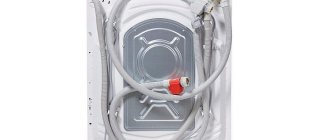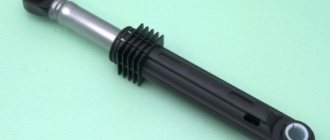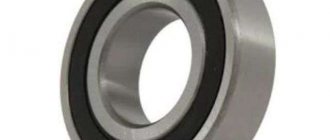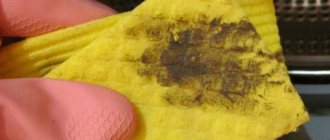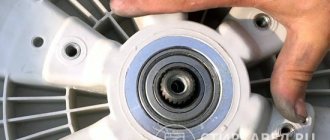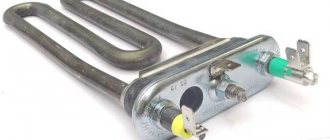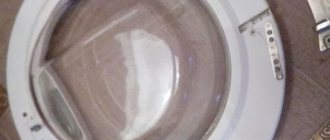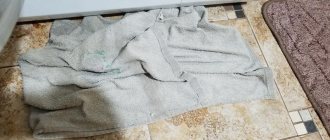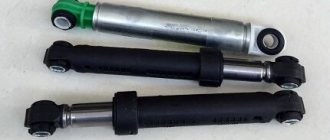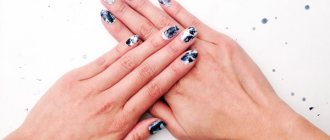Failures and breakdowns often occur in the operation of washing machines, but many problems can be dealt with on your own, without turning to a specialist for help. Thus, each user can remove the rubber band from the drum of the washing machine, clean it or replace it with a new one.
Why did this problem occur?
There are quite a few reasons why an urgent replacement of the rubber seal or, in other words, the hatch cuff was required. Here are the most common versions.
- Natural wear and tear of a part that occurs due to the long service life of the machine. During operation of the drum, strong vibration occurs, therefore, over time, the rubber simply wears out, cracks and microdamages appear.
- Mold formation on the inside of the rubber band. Appears due to the use of low-quality household chemicals: powders, gels, rinses. Read about how to get rid of mold here.
- Damage (cracks, tears) to the cuff due to washing hard objects. It happens that before washing we forget to take various small things out of our pockets: coins, keys, key rings, pens, paper clips. A potential danger can be caused by washing clothes with large fittings and metal elements: buttons, locks, rivets.
- If washing occurs in hard water and softeners are not used, limescale is gradually deposited on the internal elements of the machine, which can also lead to future replacement of the rubber seal.
You can tell that it’s time to change the cuff of the washing machine hatch by the formation of water under the machine.
After all, it is the leak that mainly signals the emergence of a problem. As a result, all this can lead to a short circuit in the electrical network and complete failure of the unit. In order to remove the cuff and install a new one in its place, it will take you from 20 minutes to an hour, depending on the complexity of the problem of the washing machine model.
The appearance of the first signs of the need for repairs
The following circumstances and facts will tell you when the rubber band needs to be replaced:
- Hissing or rattling noise, even during normal wash cycles.
- Inability to close the hatch properly.
- Formation of puddles under the machine during operation.
The washing program stops immediately if at least one of the above defects appears. The device must be disconnected from the power supply. Next, measures are taken to determine the causes of the malfunction. And repairs are being carried out.
Where to begin
First of all, we go to the store of spare parts for automatic washing machines. You need to choose a seal that completely matches the make of the car. The cuff must be identical to the old one, otherwise it will not install tightly or not at all.
Before starting work, make sure that the machine is completely disconnected from the power supply.
Remember: any repair work, including replacing the washing machine hatch cuff, is carried out only with the appliance turned off!
Internal clamp: correct installation
In repair work, this is one of the most difficult moments. Only after checking the correct installation of the cuff, the master begins to restore the clamp:
- Several bolts are used to keep the hatch locked. They get rid of them, it’s more convenient.
- A screwdriver is inserted through the blocking hole. After this, you need to hook the clamp so that it is fixed for further work.
- The next stage assumes that the part is stretched around the entire perimeter, the direction does not matter. The main thing is to control the fixation, along with the tension force. The clamp easily comes off with any careless movements. After this, the work has to be repeated again.
- The screwdriver is pulled out as soon as the clamp is in place.
- All that remains is to check how correct the installation was. The planting density should be high enough.
Removing the cuff
How to replace the hatch seal without damaging other parts? You don't need any special tools for this; round-nose pliers and a flat-head screwdriver will suffice. Just in case, prepare a cleaning agent and a cloth to remove limescale, mold and other dirt, if any.
- For ease of operation and free access to the rubber gasket, you need to remove the front panel of the machine body. Remove the powder tray and remove the screws holding the top and bottom panels in place. Then comes the turn of screws for the front of the car. When removing all the panels, remember which screws belong to which panel: they should not be confused.
- When the front panel of the washing machine is removed, you can also disconnect the hatch cuff itself. The rubber seal for a washing machine is usually attached to the tank body with two clamps. If the clamp is made of metal and is held in place by a spring, simply pry it with a screwdriver and pull it towards you. Remove additional screws. Sometimes the clamp is made of plastic and it is much easier to remove than a metal one.
- After removing the first clamp, unfasten the upper part of the elastic band. On it you will see a mounting mark that indicates the correct location in relation to the machine tank.
- Similarly to the fixing collar, remove the second one and release the cuff to be replaced completely. There is a second mark on its lower part. Please note that there are also similar marks on the rim of the hatch - by following them, you will then be able to correctly install the new cuff.
Disassembling the machine
The cuff is difficult to replace without disassembling the washing machine, so we’ll start with disassembly. We go around the back of the machine and unscrew the screws that hold the top cover. Pull the lid towards you and lift it up.
Now we go around the front of the car. We need to get the powder tray out so that it doesn't interfere with our removal of the control panel and front wall. Pull the powder tray out towards you until it stops, press the plastic tab in the center and remove the powder receptacle completely.
Having pulled out the powder receptacle, you will see that there are two screws to the right and left of its niche. We unscrew these screws as carefully as possible using a Phillips screwdriver.
Now we need to remove the control panel of the LG washing machine. There are special latches on the back of the control panel behind the end of the housing. You can press them out using the same Phillips screwdriver. We press the latches one by one and carefully pull off the control panel.
Proceed with caution; there will be a large bundle of wires trailing behind the control panel. There is no need to disconnect them, just place the removed panel along with the wires on top of the corner of the machine body.
We take a flat screwdriver in our hands and squat down. We hook on the manhole cover that covers the garbage filter. This cover is located at the bottom on a narrow decorative panel.
Having opened the lid, we move aside the emergency drain hose, which may interfere with access to the fastening element. Using a Phillips screwdriver, unscrew the screw that holds the decorative panel. The screw is located to the right or left of the filter, depending on the LG CM model. Carefully grasp the decorative panel and pull it off the latches, first on the right side, then on the left.
We open the hatch door wide, take a flat-head screwdriver and try to remove the front clamp of the hatch cuff. This needs to be done precisely at this stage, since this clamp will interfere with removing the front wall of the SM housing. We find the spring on the clamp. The spring can be located both above and below. We pry up the spring with a flat screwdriver and, moving it towards ourselves, carefully pull off the clamp.
Instead of a flat-head screwdriver, you can take a dull table knife; it will be even better for this operation.
At this stage of disassembly, we cannot yet remove the door sealing rubber. But we can tuck it inside the drum so that its edges do not catch the front wall of the case during further disassembly. Thread the cuff into the drum. Next, unscrew the two screws that hold the UBL of the LG washing machine. There are screws to the right of the hatch and you will need a Phillips screwdriver to remove them.
To release the front wall of the LG washing machine, you need to unscrew five more screws. First unscrew the two screws on top, and then the two screws on the bottom.
Using a screwdriver, carefully press the UBL out of the front wall so that it falls inside. Now you can remove the front wall and put it aside. There is no need to specially remove the hatch cover; let it remain assembled with the front wall of the machine body. Next we need to remove the hose attached to the cuff fitting.
Installing a new cuff
Before installing the new sunroof seal, make sure that it matches the exact make of your car, otherwise the seal will not be strong as a result. Thoroughly wash the so-called “rim” of the hatch to remove accumulated dirt, lime and mold. To do this, just take any soap solution.
It is not necessary to rinse off the soap: by sliding it will be easier for you to install a new rubber band, because the new part is most likely dense and inelastic.
We check whether the mounting marks on the edge of the tank and the cuff itself match, and pull the cuff onto the hatch. We hold the lower part with our fingers, pulling the upper part, then vice versa. The same soap solution will be useful as a lubricant.
Next, we proceed in the same way as when removing the rubber. We return the clamps to their place, tighten the screws and check whether the cuff is firmly seated. After all, if the installation turns out to be of poor quality, leaks are possible in the future.
To make sure that you have successfully replaced the sealing rubber, run the wash cycle on a short program without placing any items in the hatch. After the process is completed, look to see if any water appears in the area of the bottom of the cuff.
Tips for removing internal clamps
You need to find the location of the seal and all the parts, and then remember where and what is located. It is recommended to make special notes for this. Then the new cuff will be installed correctly, following the recommendations for maintaining tightness.
After this, dismantling of the internal holders is allowed. It is enough to pull the device in your direction. At the next stage, the elastic band is changed, the grooves are completely cleaned if necessary. You can use a soap solution, it makes the work easier in the future.
Types of windshield wipers
Modern car models can have three types of wipers. They are divided into:
- Frameless;
- Frame;
- Hybrid.
The peculiarity of frameless structures is the presence of a plastic body and metal plates. An elastic band is attached between them. This type of model is highly expensive.
Frameless windshield wipers can be made individually for any vehicle model. During the production process, the make of the car and its dimensions are taken into account.
What are frame wipers? A similar version of windshield wipers was developed for domestic and Soviet cars. All elements of the mechanism were made from metal alloys, but modern manufacturers prefer to use plastic.
This material allows you to reduce financial costs and also make products more streamlined.
The design of frame wipers consists of the following elements:
- Supports;
- Rocker arms;
- Adapters;
- Hinges;
- Rubber bands;
- Fixing plates.
The device of hybrid wipers combines supports and rocker arms. They are made of a plastic housing, which is used for frameless models of windshield wipers. This type of wipers is considered expensive, but durable.
Prevention measures
In order to encounter cuff malfunctions as little as possible, it is necessary to follow simple preventive measures.
- After each wash, wipe the cuff with a dry cloth to remove any remaining water. Otherwise, pathogenic microflora will actively multiply, and with constant contact with water, rubber will lose its performance characteristics.
- Powder residues gradually collect in the grooves of the seal and turn into a thick coating. It must be removed periodically, since washing agents have a detrimental effect on the characteristics of rubber.
- When loading things, you should carefully check the contents of your pockets. Foreign objects in the drum during washing can damage the cuff and render it unusable.
- The manufacturer's recommendations regarding the weight of the laundry to be loaded must be strictly followed. Not only the maximum, but also the minimum weight is important.
- Clothes with iron elements and large decor should be washed in special bags, which are also necessarily used for shoes.
- Cleaning the washing machine using special products should be carried out regularly - at least 2 times a year. It is advisable to carry out complete mechanical cleaning every two years.
- The hatch should be slightly open if the machine is not in use, which will provide ventilation.
Watch a video about replacing the cuff below.
